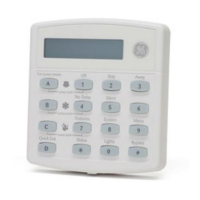Concord
57
The following sections describe the settings that appear under ONBOARD OPTIONS—OUTPUT PRO-
GRAMMING
.
Smoke Verify (1100)
Onboard Options-Inputs (Default = off)
This setting controls the number of sensor group 26 (fire) zone
trips needed to report a fire alarm.
• Hardwire Smokes: will determine whether or not the panel
requires two alarm signals within five minutes (on) from 2-
wire smoke detectors connected to panel zone input 6 and/or
SnapCard zone inputs or any other hardwire zone learned
into group 26 (fire) before activating system sirens and
reporting to a central station (or pager).
• Wireless Smokes: the first trip of a group 26 RF sensor will
cause a local fire alarm. The second trip of any group 26
zone within the siren timeout will cause that fire alarm to be
reported to the central station.
Note
RF smoke detectors repeat the alarm transmission every 60 sec-
onds as long as they are detecting smoke. This repeated transmis-
sion will serve as the second zone trip, causing the alarm to be
reported.
¾To turn Smoke Verify off or on:
1. With the display showing ONBOARD OPTIONS, press #
twice. The display shows
SMOKE VERIFY OFF/ON (cur-
rent setting).
2. Press 1 (off) or 2 (on). The display flashes the entered
number.
3. Press # and the display shows the new setting.
Note
For California State Fire Marshall Listed installations, this feature
must be off.
Two Wire Smoke (1101)
Onboard Options-Inputs (Default = off)
This setting determines how onboard hardwire zone 8
is configured. When this setting is on, zone 8 will be
configured for two wire smoke detectors. When off, it
will be configured for a normal hardwire input.
¾
To turn Two Wire Smoke off or on:
1. With the display showing ONBOARD OPTIONS, press # twice. The
display shows
SMOKE VERIFY OFF/ON (current setting).
2. Press A or B until the display shows
TWO WIRE SMOKE ON/OFF
(current setting).
3. Press 1 (off) or 2 (on). The display flashes the entered number.
Press # and the display shows the new setting.
Output 1, 2 (Output 1: partition assign-11100,
configuration-11101; Output 2: partition
assign-11110, configuration-11111)
Onboard Options-Output-Programming
(Defaults: Output 1=Ptn 1, 01614; Output 2=Ptn 1, 01710)
This setting lets you assign the partition and the 5-digit
configuration number. The configuration number deter-
mines
• which system event activates the selected output, and
• the duration or time the output is activated.
The first three digits represent the trigger number of an
event (such as triggering an alarm, opening a sensor, or
arming the system). The last two digits represent how the
output responds (such as momentary switching, main-
tained (or latched) switching, or switching for a preset
time).
Note
If you want to configure an output for user Output Control you
must use the Output Text feature to name the output. If no Out-
put Text is programmed, Output Control will not function for
that output.
Use the system event trigger and response numbers listed
in Appendix B: Reference Tables.
¾
To set up onboard Output 1 & 2 partition and configuration
assignments:
1. With the display showing ONBOARD OPTIONS, press # + B.
The display shows OUTPUT PROGRAMMING.
2. Press # and the display shows
OUTPUT 1. Press B to select
OUTPUT 2.
3. Press # and the display shows PARTITION ASSIGN n (current
setting).
4. Press 1 or 2 to assign the output to the desired partition, then
press #. The display shows
PARTITION ASSIGN (new setting).
5. Press B and the display shows
CONFIGURATION tttrr (current
setting).
6. Enter the desired configuration number. The display flashes
the entered number. Press # and the display shows the new
setting.
7. Press # and repeat steps 2 through 6 until all outputs are pro-
grammed.

